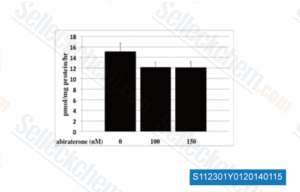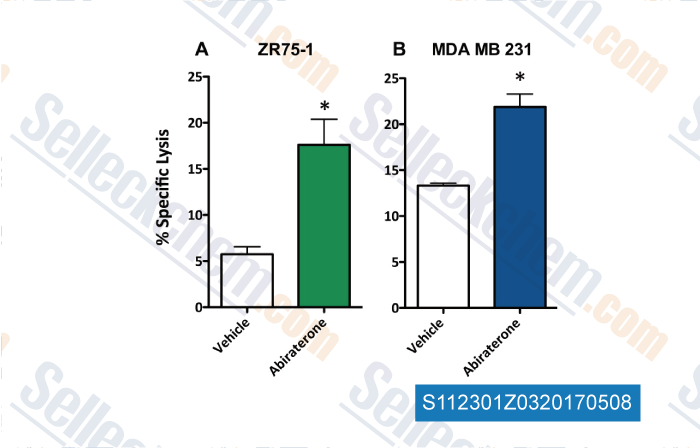|
受注:045-509-1970 |
技術サポート:[email protected] 平日9:00〜18:00 1営業日以内にご連絡を差し上げます |
化学情報

|
Synonyms | CB-7598 | Storage (From the date of receipt) |
3 years -20°C powder 1 years -80°C in solvent |
| 化学式 | C24H31NO |
|||
| 分子量 | 349.51 | CAS No. | 154229-19-3 | |
| Solubility (25°C)* | 体外 | Ethanol | 0.2 mg/mL (0.57 mM) | |
| DMSO | 0.1 mg/mL (0.28 mM) | |||
| Water | 0.02 mg/mL (0.05 mM) | |||
|
* <1 mg/ml means slightly soluble or insoluble. * Please note that Selleck tests the solubility of all compounds in-house, and the actual solubility may differ slightly from published values. This is normal and is due to slight batch-to-batch variations. |
||||
溶剤液(一定の濃度)を調合する
生物活性
| 製品説明 | Abiraterone is a potent CYP17 inhibitor with IC50 of 2 nM in a cell-free assay. Abiraterone (CB-7598) is an androgen biosynthesis inhibitor. |
|---|---|
| in vitro | Abiraterone binds and inhibits wild-type and mutant androgen receptor (AR). Abiraterone inhibits in vitro proliferation and androgen receptor-regulated gene expression of androgen receptor-positive prostate cancer cells, which could be explained by androgen receptor antagonism in addition to inhibition of steroidogenesis. In fact, activation of mutant androgen receptor by eplerenone is inhibited by greater concentrations of Abiraterone. Abiraterone displaces ligand from both WT-AR and T877A with EC50 of 13.4 μM and 7.9 μM, respectively. [2]Abiraterone inhibits lyase activity with an IC50 of 5.8 nM in rat testis microsomes. Abiraterone acetate significantly inhibits T secretion (−48%) and in turn increased LH concentration (192%).[3] |
| in vivo | Abiraterone inhibits CYP17 with an IC50 of 72 nM, in human testicular microsomes. [4] Abiraterone fails to significantly reduce the size of any of the organs. [5] Abiraterone reduces the testosterone levels strongly, almost reaching the level of the orchiectomy control. The testosterone levels are reduced by Abiraterone for more than 95% compared to the control group. [6] |
| 特徴 | Approved for the treatment of docetaxel-treated castration-resistant prostate cancer. |
プロトコル(参考用のみ)
| キナーゼアッセイ | C17,20-lyase activity assay | |
|---|---|---|
| Microsomes are diluted to a final protein concentration of 50 μg/mL in the reaction mixture which contained 0.25 M sucrose, 20 mM Tris–HCl (pH 7.4), 10 mM G6P and 1.2 IU/mL G6PDH. After equilibration at 37 °C for 10 minutes, the reaction is initiated by addition of βNADP to obtain a final concentration of 0.6 mM. Prior to the distribution of 600 μL of the reaction mixture in each tube, Abiraterone is evaporated to dryness under a stream of nitrogen and then are incubated at 37 °C for 10 minutes. After incubation with Abiraterone, 500 μL of the reaction mixture is transferred to tubes containing 1 μM of the enzyme substrate, 17OHP. After a further 10 minutes incubation, tubes are placed on ice and the reaction is stopped by addition of 0.1 ml NaOH 1N. Tubes are deep-frozen and stored at −20 °C until assayed for Δ4A levels. A Δ4A RIA is developed and automated on a microplate format using a specific antibody against Δ4A. The separation of free and bound antigen is achieved with a dextran-coated charcoal suspension. After centrifugation, aliquots of the clear supernatant are counted in duplicates in a 1450 MicrobetaPlus liquid scintillation counter. The Δ4A concentrations of unknown samples are determined from the standard curve. The detection limit is 0.5 ng/mL and the within and between assay coefficients of variation are 10.7 and 17.6%, respectively at an assay value of 13 ng/mL. The rate of enzymatic reaction is expressed as pmol of Δ4A formed per 10 minutes and per mg of protein. The value of maximum activity without inhibitor (control) is set at 100%. The IC50 values are calculated using non-linear analysis from the plot of enzyme activity (%) against log of inhibitor concentration. | ||
| 細胞アッセイ | 細胞株 | LNCaP and VCaP cells |
| 濃度 | 0.1-5 μM | |
| 反応時間 | 24 hours or 96 hours | |
| 実験の流れ | LNCaP and VCaP cells are seeded in 96-well plates and grown in CSS-supplemented phenol red-free or FBS-supplemented media for 7 days. Cells are treated with Abiraterone at 24 hours and 96 hours after plating and cell viability is determined on day 7 by adding CellTiter Glo and measuring luminescence. | |
| 動物実験 | 動物モデル | LAPC-4 xenograft mice |
| 投薬量 | 0.15 mmol/kg | |
| 投与方法 | Administered via s.c. | |
参考
カスタマーフィードバック

-
Data from [Data independently produced by Prostate, 2013, 74, 235-49]

-
Data from [Data independently produced by , , Oncotarget, 2016, 7(17):23498-511]
Selleckの高級品が、幾つかの出版された研究調査結果(以下を含む)で使われた:
| Bayesian Machine Learning Enables Identification of Transcriptional Network Disruptions Associated with Drug-Resistant Prostate Cancer [ Cancer Res, 2023, 83(8):1361-1380] | PubMed: 36779846 |
| Proteogenomic characterization identifies clinically relevant subgroups of intrahepatic cholangiocarcinoma [ Cancer Cell, 2021, S1535-6108(21)00659-0] | PubMed: 34971568 |
| Genetic Suppressor Element 1 (GSE1) Promotes the Oncogenic and Recurrent Phenotypes of Castration-Resistant Prostate Cancer by Targeting Tumor-Associated Calcium Signal Transducer 2 (TACSTD2) [ Cancers (Basel), 2021, 13(16)3959] | PubMed: 34439112 |
| Antiproliferative, proapoptotic, and tumor-suppressing effects of the novel anticancer agent alsevirone in prostate cancer cells and xenografts [ Arch Pharm (Weinheim), 2021, e2100316] | PubMed: 34668210 |
| Stepwise binding of inhibitors to human cytochrome P450 17A1 and rapid kinetics of inhibition of androgen biosynthesis [ J Biol Chem, 2021, 297(2):100969] | PubMed: 34273352 |
| Abiraterone induces SLCO1B3 expression in prostate cancer via microRNA-579-3p [ Sci Rep, 2021, 11(1):10765] | PubMed: 34031488 |
| Effects of MTX-23, a Novel PROTAC of Androgen Receptor Splice Variant-7 and Androgen Receptor, on CRPC resistant to Second-Line Antiandrogen Therapy [ Mol Cancer Ther, 2020, molcanther.0417.2020] | PubMed: 33277442 |
| Dual-mTOR Inhibitor Rapalink-1 Reduces Prostate Cancer Patient-Derived Xenograft Growth and Alters Tumor Heterogeneity [ Front Oncol, 2020, 10:1012] | PubMed: 32656088 |
| Bioactivity of Curcumin on the Cytochrome P450 Enzymes of the Steroidogenic Pathway. [ Int J Mol Sci, 2019, 20(18)] | PubMed: 31533365 |
| CYP17A1 Maintains the Survival of Glioblastomas by Regulating SAR1-Mediated Endoplasmic Reticulum Health and Redox Homeostasis. [ Cancers (Basel), 2019, 11(9)] | PubMed: 31527549 |
長期の保管のために-20°Cの下で製品を保ってください。
人間や獣医の診断であるか治療的な使用のためにでない。
各々の製品のための特定の保管と取扱い情報は、製品データシートの上で示されます。大部分のSelleck製品は、推薦された状況の下で安定です。製品は、推薦された保管温度と異なる温度で、時々出荷されます。長期の保管のために必要とされてそれと異なる温度で、多くの製品は、短期もので安定です。品質を維持するが、夜通しの積荷のために最も経済的な貯蔵状況を用いてあなたの送料を保存する状況の下に、製品が出荷されることを、我々は確実とします。製品の受領と同時に、製品データシートの上で貯蔵推薦に従ってください。
